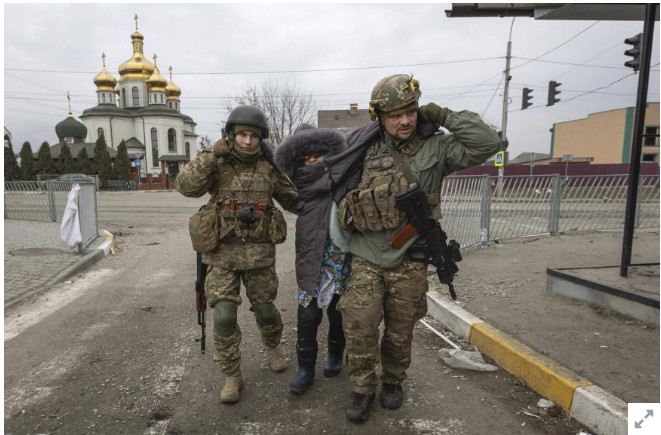
Photo: webshot
March 08, 2022
For several hours on March 6, 2022, Russian forces bombarded an intersection on a road that hundreds of civilians were using to flee the Russian army’s advance in northern Ukraine to Kyiv, Human Rights Watch said today. The repeated nature of the attacks, which according to the government killed at least eight civilians, suggests that Russian forces violated their obligations under international humanitarian law not to conduct indiscriminate or disproportionate attacks that harm civilians, and failed to take all feasible measures to avoid civilian casualties.
According to witnesses, about a dozen Ukrainian security force members and at least two military vehicles were at the intersection during the attack, but they were vastly outnumbered by the large number of fleeing civilians. Some security forces were helping the civilians carry their luggage and children. Witnesses described hearing and seeing exchanges of fire between Ukrainian and Russian forces not in the immediate vicinity of the intersection, but at some distance away. While other witnesses could not be precise about where the exchanges of fire took place, the New York Times, which had journalists on the scene, reported that Ukrainian forces fired mortar rounds in the direction of the Russian forces from a military position about 180 meters from the intersection. Nevertheless, explosive projectiles fired by Russian forces repeatedly hit the intersection.
“Scores of civilians fleeing northern Ukraine to escape Russian shelling and potential occupation found themselves victims of yet another Russian assault,” said Richard Weir, crisis and conflict researcher at Human Rights Watch. “The hours-long bombardment on a location with evacuating civilians raises concerns that Russian forces were conducting indiscriminate or disproportionate attacks, and failing to take all feasible precautions to minimize civilian casualties.”
Human Rights Watch research and analysis suggests that the projectiles used in the bombardment were possibly observed, meaning that Russian forces were likely tracking or “observing” where they were landing, and that Russian forces had information they could use to adjust targeting. If this is the case, the persistent shelling harming civilians rather than hitting larger military objectives some distance away points to potential recklessness or deliberateness.
Human Rights Watch interviewed seven people who were present during the attacks on March 6, including five linked to the media and two civilians who were evacuating, and analyzed one video of a projectile hitting the intersection and six photographs of the aftermath. According to the local mayor, eight people were killed, including two children. Human Rights Watch gathered information about four people killed during the shelling, including two children, from witness accounts and analysis of photos and videos.
From about 9:30 a.m. until 2 p.m. local time, witnesses described continuous bombardment on the P30 road, which runs from northwestern Ukraine to Kyiv. Until March 5, civilians had been taking the train from Irpin station into Kyiv to escape the fighting, but the railway tracks were damaged in an attack that day. As a result, on March 6, hundreds of civilians fleeing areas north of Kyiv used the P30 road to reach Kyiv, from which they hoped to travel onward.
The intersection is six kilometers from the Kyiv city limits, south of Irpin, just in front of St. George’s Ukrainian Orthodox Church and a statue commemorating those who fought in World War II. The intersection is also just south of a bridge that the Ukrainian forces destroyed to deter the Russian advance.
